The year 2020 is going to go down in history as one of the most difficult years that our combined generations have lived through. We have yet to see what the final death toll from COVID-19 is going to be. But there’s another toll that will have to be tallied as well; that’s the effect that months of a shutdown are going to have on the national and global economy. Are we going to end up in a global depression?
But probably the most memorable thing that this year will be known for, more than even the pandemic, is as the year of the Great American Toilet Paper Shortage.
For some unknown reason, the panic associated with the COVID-19 pandemic has sparked a run on toilet paper, even though it is a respiratory disease and not a gastrointestinal one.
We may never know what has caused the Great American Toilet Paper Shortage; but we’re going to have to live with it.
Related: Homemade Substitutes for Toilet Paper
That either means getting up at a ridiculous hour of the morning, in order to stand in line outside the grocery store, watching the sun rise and hoping that the store will have received some toilet paper overnight. If luck is with you, you’ll only have to do that once; but if not, you may have to do it several days in a row, in order to get your hands on some of those precious rolls.
That almost sounds a bit like a craps game; you pay your money and you take your chances. On the other hand, you can go with one of the other options out there. Some people are touting the idea of using cloth and leaves, in place of toilet paper. After all, we haven’t always had toilet paper to use and people had to use something.
Too bad Sears isn’t still putting out their “big book” like they did for so many years.
Those adorned many an outhouse, alongside a burlap sack of corn cobs, once the new catalog came out. But we can’t count on Sears for that one anymore. If we want paper for our bums and can’t find it elsewhere, we’ll just have to make our own.
Actually, our own will probably be a whole lot better than the Sears catalogue anyway… and who wants to use a corn cob? Sounds scratchy!
What’s it Going to Take?
If you’re someone who collects newspapers for recycling, you’re in great shape. You already have the number one ingredient you need, so that you can make your own toilet paper. While you can use other kinds of paper to make your TP, newsprint will break down easier and produce a softer paper.
Besides newspapers, you’re going to need:
- More newspapers
- Water
- Bucket
- Paper shredder
- Electric mixer
- Plastic storage bin
- Frame to fit in the storage bin
- Screen material
- Staple gun
- Putty knife
- Something to cut your TP with
- Something to roll your TP on
Making Your Own Toilet Paper
The first thing we need to do, in order to turn that newspaper into toilet paper, is to break the newspaper down. This can be easily done with water, especially if you give that water a little mechanical help.
- Shred the newspaper with a paper shredder. The smaller your paper shredder shreds the paper, the better. If you don’t have a paper shredder, you can cut or tear the newspaper into strips; but it might need to soak in water longer.
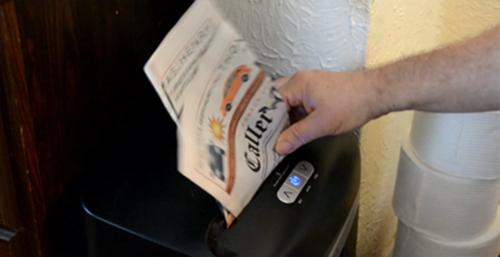
- Place your shredded newspaper in the bucket and cover it with water. You only need enough water to barely cover the shredded newspaper. Any more is a waste.
- Allow the newspaper to sit in the water for 24 hours.
- Using an electric mixer, chop up the wet newspaper, making it into pulp.
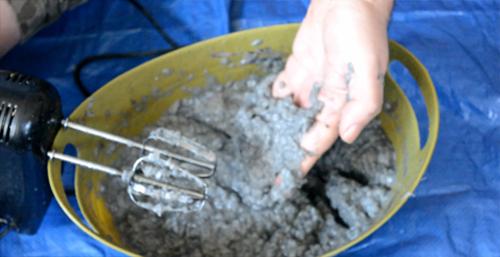 While your newspaper is soaking, it’s a good time to make your screen frame. It needs to be as big as possible, but still sit in the bottom of your plastic storage bin. I used 1”x 2” pine for this, but you can use wider boards if you want to. There are a number of different ways you can assemble this frame, but the easiest way is to make butt joints in the corners and pin them with dowels, as I show in the video.
While your newspaper is soaking, it’s a good time to make your screen frame. It needs to be as big as possible, but still sit in the bottom of your plastic storage bin. I used 1”x 2” pine for this, but you can use wider boards if you want to. There are a number of different ways you can assemble this frame, but the easiest way is to make butt joints in the corners and pin them with dowels, as I show in the video.
The reason I chose to dowel the corners of the frame was that glue doesn’t stick well to end grain.
This frame is going to sit in water and I don’t want the joint to loosen up. Screws don’t work well into end grain either, although nails do. So you could choose to nail it, but it’s just as easy to use dowel pins.
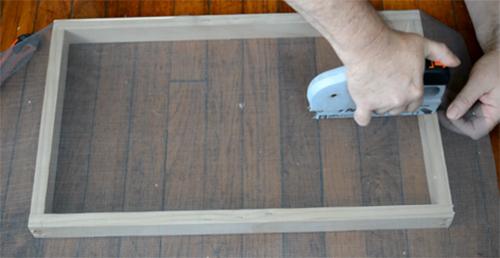
To dowel a joint of this type, first clamp the two parts making the corner of the frame, so that they are positioned properly, with the edges flush.
Then drill two holes of the appropriate size for the dowel being used. I used 3/8” dowels, so I drilled my holes with a 23/64” drill bit, drilling through the lap board, into the end grain of the other board. I made sure to drill the holes deeper than the length of the dowels.
Related: The Self-Sufficient Backyard (Video)
With the holes drilled, I spread glue into the splines cut into the sides of the dowel pins with my finger. I then placed them in the holes and drove them flush with a wood mallet. Once all the corners were properly pinned together, I set the frame aside to dry.
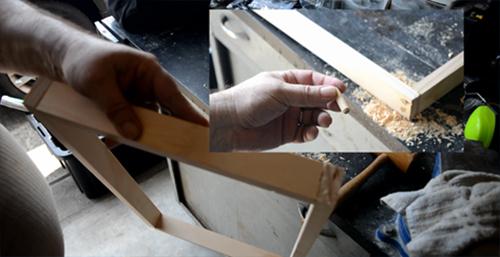
Finally, staple screening material onto one side of the frame, working from the center outwards.
It doesn’t need to be as tight as what you would do for a window, but it should be flat and smooth. If your staples don’t go all the way in, hammer them flush with the top of the wood, so that they will grip the screening properly.
Now that your newspaper pulp and your frame are ready, it’s time to make the toilet paper.
- Place your frame into the bin and fill it with water. Ideally, the water should come to just below the top of the frame.
- Scoop up a portion of the newspaper pulp, roughly equal to two cups (the quantity isn’t exact, as your bin might be a different size than mine) and put it in the water, mixing it with the water and spreading it out to fill the entire area.
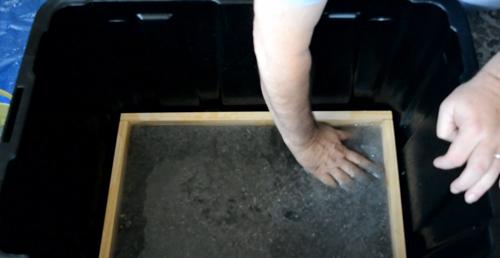
- Slowly lift the frame out of the water, looking to see, as the water drains out, that the shredded newspaper pulp is evenly spread across the entire are of the screening.
- Allow as much water as possible to drain out of the newspaper pulp.
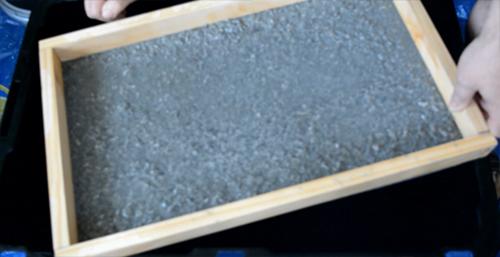
Now we need to dry the pulp, allowing it to bond back together and turn into paper.
- Set up an ironing board and cover it with a piece of absorbent cloth. An old towel will work. Place the frame, screen side down, on top of this cloth.
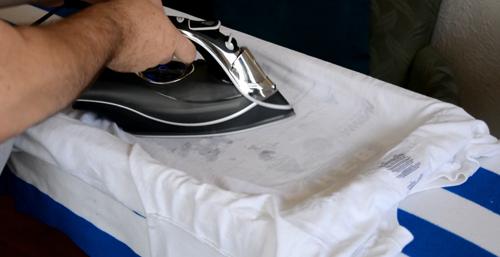
- Place another absorbent, but smooth cloth on top of the newspaper pulp inside the frame. An old T-shirt will work.
- Using a clothes iron, set for ironing cotton, iron the cloth, heating the newspaper pulp and drawing the moisture out of it. You’re trying to do two things here; one is to draw the moisture out, and the other is to flatten the surface of the paper. If you don’t iron it, you’re going to end up with some rather scratchy paper.
- Place the frame in the sun to finish drying. You could try drying it all the way with the iron, but that will take a long time.
With the paper dry, we’re ready to make it usable in the bathroom.
- Take a wide putty knife, preferably a plastic one, and use it to break your sheet of toilet paper free of the frame around the edges. Be careful not to cut through the screen, so that you can reuse it.
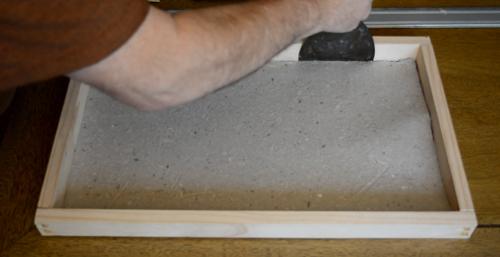
- Flip the frame over so that the screen side is up and push down gently on the screen, all around the edges. This should break the paper free from the screen. Continue through the middle of the paper as well.
- Flip the frame back over, paper side up and work one corner of your paper free, then pull up the rest, taking care not to tear it.
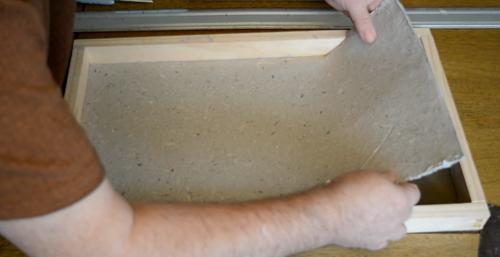
- Measure the paper, marking it to the width of a toilet paper roll. If you don’ t have any toilet paper rolls to put your homemade TP on, you can cut paper towel or wrapping paper rolls down to four-inch segments.
- Roll the paper onto the cardboard tube, overlapping pieces over each other.
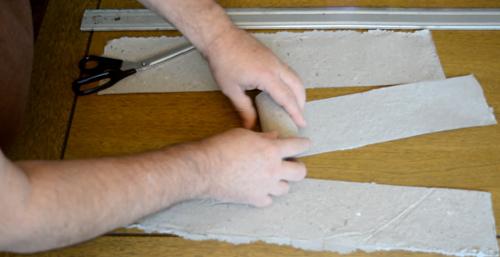
Your finished toilet paper is going to be thicker than store-bought, even though it is only one single ply.
That means you can use less of it, which I’d recommend, considering that it’s a bit harder to make than just going to the store and buying a four-pack of Charmin. But then, if you could do that, you wouldn’t need to make your own.
* Here is a video on how to make a toilet paper.
[ot-video type=”youtube” url=”https://www.youtube.com/watch?v=177Qnu-nalE”]
You may also like:
Watch Out for These Toilet Paper Eating Bugs
Woman With MS Survives in the Wild With Just a Knife and the Plants She Found (Video)
DIY Seed Tapes With Toilet Paper
Toilet Paper Pills – The Best Invention You Didn’t Know Existed

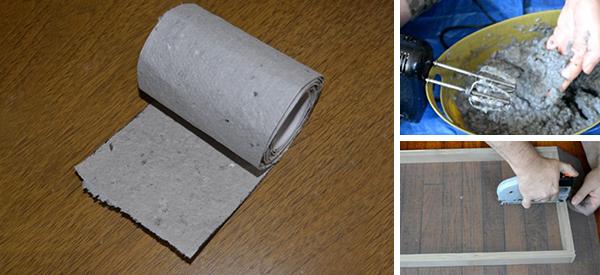














considerations for septic system?
Shredded newspaper will decompose in the septic tank. The biggest problem is making it thin enough that it will fall apart in the toilet so it will flush to the septic tank.
using filtered gray water and a handpump bidet might be easier
Phrog: Better to build a small methane digester. People in 3ed world nations are doing that for gas and fertilizer. niio
Man, if it gets down to this then I would be spending a lot of time just making TP.
lol…that’s all I got to say.
Newspaper inks are vegetable based now.
Will this clog up the plumbing? Especially in older homes this is a concern. I know that “flushable” wipes are not— and this homemade TP is similar.
Hard to say, Mick. I would think it depends upon how thick you make the paper and how much you use each time. Might be better to do what they do in some countries, put the paper in a paper bag and burn it first chance.
I haven’t a clue what it would do to a septic system but I don’t think it would be good, whatever it does.
When I was a kid, we used news paper a lot and the pipes were always blocked.
Newspaper will break down in the septic tank over time. However if the paper is not chopped up into very small pieces it would clog a drain pipe because the newspaper sheet does not break down and come apart very quickly. Toilet tissue is designed to fall apart after 3 seconds in water. Flushable wipes will flush but don’t flush them. They contain longer synthetic fibers and a binder that does not break down in water. You can see the difference if you put one in your kitchen mixing bowl with water. When you turn the mixer on you will see that the flushable sheet does not easily come apart. The sheets can snag and build up in the drain line clogging the line and if they do make it to a septic tank the synthetic fibers will slowly build up in the septic tank until the tank is full. If you are on city sewers the sheets can build up in the pipes causing clogs there too and if they make it to the pumping station, the sheets can clog pump impellers.
The shortage all started from the first people to be quarantined. When interviewed after their 2 weeks, they said the worst thing was when they ran out of toilet paper. And so it began…
My father used to make his own wooden screens and storm windows. While I haven’t used them in years myself, there are corrugated fasteners made just for the purpose of butting wood together. they are approximately one inch long by 1/2 inch high and are sharp on one of the long sides. They are tapped in with a light hammer. You won’t want to drive them like you would a six penny nail. They effectively join two pieces of wood. They work best if used on a mitered joint but will work on a butted joint as well.
In addition, if you want to make your joints sturdier, you can use L-shaped pieces of metal which have screw holes in them and are designed for just such a project. They come in varying lengths. I don’t know their official name. The small neighborhood hardware store knew what I was talking about when I described them, so I never really did learn the name. I haven’t used them in years so I don’t know if the big box hardware stores carry them. You might have to search out a small neighborhood hardware store that has been in business for 50 or more years.
Because the legs are about 2 1/2 inches long they make a nice secure joint. If you put one on each side of the joint it makes it practically indestructible. You can put it over the screen on the screen side and it will help secure the screen to the wooden frame.
Traditionally this is how paper was made before the Fordrinier Brothers invented their continuous paper making machine in the 19th century.
It is how washie paper is still being made in Japan. Washie is very expensive Japanese paper used in many decorative ways and also for artistic calligraphy. It is made on paper forms that are closer to 1 meter by 2 meters and are suspended with ropes on pulleys over the slurry tank. If my recollection serves me correctly, it is made from the pulp of the mulberry tree.
If you want to make paper in the traditional size it is 17 1/2 by 22 1/2. That allows it to be folded in quarters and trimmed to 8 1/2 x 11 to make an 8 page booklet.
The side that is ironed is called the felt side and the side that is against the screen is called the wire side. If you examine a sheet of bond paper very closely with an 8x linen counter you can see the wire marks. When printing a sheet you want to print on the felt side. It gives you a sharper impression on the paper. Paper made on a Fordrinier machine has a grain to it. Most paper is cut to make the grain run with the long side. You can tear a sheet down the grain easier than you can tear it across the grain.
Rich doesn’t say so, but you want to make paper someplace that having lots of water on the ground won’t make a difference. Outdoors or in the garage. You definitely don’t want to make it in the kitchen unless you want to mop the floors anyway. Paper pulp holds a lot of water. When you press that water out of the paper pulp it needs to go somewhere and as we all know, water flows downhill.
The paper that you make from newsprint is not going to be very sturdy. You will have to use it carefully so that you won’t poke holes in it. Newsprint is not the best quality paper to begin with and now it is recycled cheap paper. Recycled paper generally is weaker than virgin paper because paper’s strength depends upon the strength and length of the fibers. Cotton or linen make the toughest, finest paper. U.S. currency is printed on 100% cotton paper. That’s what give it its durability.
In the 19th century, mummy wrappings were used in the paper making industry. It was a cheap source of linen fiber. Unfortunately, anthrax was a common disease in ancient Egypt and the anthrax spores were dormant in the mummy wrappings. Use of those wrappings in New England in the paper mills almost wiped out the paper making industry in New England in the 19th century from anthrax. Who knew?
We were once asked to reproduce the diary of a young woman from the first decade of the 19th century. The diary was 100% linen paper and although it was close to 200 years old, the paper was just a fine as could be. The handwriting was beautiful too. It was a very expensive book then and would be even more so now. I am not sure if 100% linen paper is even available as machine made paper. You would probably need to purchase it from a small artisan shop that specialized in exotic papers.
Besides the 20 pound bond that we all use in our copy machines and as gp office paper, there are many different kinds of paper products that have different industrial and office uses. A treatise on just the variety of sizes, finishes and weights of paper could fill a several hundred page book.
A look around your kitchen and pantry will reveal numerous kinds of paper with numerous uses from labels on bottles to egg cartons to milk cartons to all kinds of packaging. Paper is the ideal medium for long term preservation of knowledge. Gutenberg bibles printed in the 15th century when Gutenberg introduced the movable type press in Europe are still around today and are still legible. I am not sure you can say that for electronic media stored on magnetic tape only 60 years ago.
The mulberry the Japanese use for paper is Broussonetia papyrifera the paper mulberry. In the 19th century some Texans imported it trying to start a silk industry in the state, the leaves of paper mulberry are a favored food for silkworm caterpillars. There is no silk industry here but the trees are common in Texas and other southern states.
Gaugin went to Tahiti to paint, he is known to have behaved badly there but his paintings of the island women are cool. They made the fabric for their clothes from the inner bark of paper mulberry by chewing it into a paste and screening it out like the above toilet paper process. Enzymes in the saliva turn the pulp into a very soft breathable fabric which takes pigment wonderfully. I know the Cheyenne in particular were known for chewing deer hides and creating a beautiful soft doeskin fabric for their clothing. Spit is pretty useful stuff.
Paper mulberry bark was also used for early Rayon, but wood pulp was a lot cheaper so they switched to that, but it is still the same enzymatic process.
Very cool tree, you can eat the fruit and leaves and an extract of the bark is used as an astringent skin lightener, if one ever feels the need to lighten up. And the large leaves are similar to mullein leaves, a thinner lighter texture and larger, which is to say they make great toilet paper!
Wow, Mike. A very erudite post. Thanks for enlarging on my post. If that particular species of mulberry grew in Texas I wonder if it would grow in SoCal. Probably not enough rain here for it. It would take a lot of irrigation.
I have some bark paper from Samoa that a neighbor sent to me when he and his wife were in Samoa. He spent a couple of years there. He was an electronic genius. He helped install the TV system in Saudi Arabia and the school closed circuit system in Samoa. That is what he was doing. Installing closed circuit TV so that the children on the smaller islands where there weren’t enough children to warrant having a school and teacher could get classes via CCTV.
I have to get off my duff and offer it to the Natural History Museum in the town up the road from us. I had some Yonigumijima moths that I had purchased as a souvenir many decades ago when I was on Okinawa. I am sure they are now a protected species and not collectible. The insect guy at the museum was glad to get them.
Their claim to fame is that they are the largest moths in the world. The ones I had had a wing span of about a foot across. I just saw a program on NHK about diving on Yonigumijima. There are formations that folks who have examined them are divided on. Some claim they are natural formations and others claim they are manmade at a time when the seas were not as high as they are today (or the other possibility is that the land subsided either as a result of earthquake activity or some other natural event.)
Of course the water is clear and visibility extends to quite a depth. That was the best part of being stationed on Okinawa was the diving that was available with clear, warm water. One could stay in the water all day without a wet suit. It the water was in a coral lagoon during low tide it was actually hot upon entering.
Again, Mike, thanks for the augmentation. I appreciate it.
I’ll never see the Pacific Islands which makes me sad, so cool you got to do all that.
The biggest moth in the U.S. is the black witch moth (saw one last spring on the window of my tent) at 6-7 inches, half the size of the Yomi. I mention the Black Witch hoping Red will check in here cause he’ll know all the Southwestern magical beliefs about it.
Mike: don’t know from nuthin but am always on a learnig curve. I like teachers. You, for instance.
What I studied was ani, the Susos Kanona opposing spirits and listened with respect when elders here, in Arizona and Mexico taught about the dark. What shon elders taught in Pennsylvania is very close to what’s taught from Alaska to the Tierra del Fuego. Once, it was all one people, no?
You research, you find. Did you ask a local curandero or Comanche healer? When I wanted to find out more about the Anasazi, I asked their offspring, Hopi and Zuni, the Tohono here and in Mexico. It took Rich Fisher, Canyons Unlimited, not an archaeologist, to unlock out what happened to them.
Tucson is still called Tsuk Shon, witch waters, by Tohono. The word shon is used from Siberia to Peru to the Tierra del Fuego. Rattlesnake is wherever she’s found called World Destroyer. Ghosts in the Americas scream Boo!/Satan, while in the rest of the world groan and scream. Owls are considered dark spirits around the world. My culture, the great horned owl is lord of darkness; ex’s in Mexico, it’s the vampire god. Everywhere coyote is, he’s a malignant spirit. But, why would I need to know all the evil? Most are so weak they need a human to work with. Your moth seems to be considered evil only with neo-Africans. Bats, except for the vampire, are scared in Native America, a gift from Creator.
https://www.desertusa.com/insects/black-witch-moth.html
I can read about the Black Witch moth and lots of other things but a lot that is of interest to me but outside of my experience has been a part of your life and, as in your last paragraph, I enjoy the happy manic way you write about things, thanks.
Mike: always good to hear from you. It tells me you’re doing well, and like with LLC, that’s good. Mind the bats there. Some white nose that killed 98% of the bats in the Northeast was found in Texas, but it’s unlikely to be a severe problem. their bats hibernate all winter, and if they’re disturbed, they wake up and can starve to death fast. In the South/Southwest, all they need to do is find a hippy and enough the flies. In Kali, sad to say, they get stoned on the smog over Haight St., and fall into the sea 🙂 niio
Ya, Mike. God and the Arkansas birds put a toilet paper tree in my back yard!
Why not just use the newspaper in its original form? Seems like a whole lot less work and gets the job done without all that time that could be used to load bullets!! LOL
It works but the paper is smooth and not very absorbent. Plus, the black ink rubs off on the skin.
this will dissolve–after all, you dissolved the newspaper to make it. short fibers and no synthetics. much recycled tp is made from newspapers. no problem.
Quicker method:
cut cardboard boxes into toilet paper sized pieces…wipe your ass with it.
I would prefer the pages from and old phone book. They store easily and tear out easily too.
How about just using a bidet or similar. A wash is always better than a wipe!
I’ve been thinking about buying a bidet for the last few months. They’re not that expensive. But I don’t think it’ll spray everything off. Need to do more research.
Bidets have become very popular in Japan Toto, the Japanese toilet maker is big into bidets. In Japan you almost have to have a license to operate them they do so many things besides just wash and dry.
The biggest drawback to a bidet in an already plumbed bathroom is that in addition to additional plumbing, it requires electrical wiring which adds considerable to the installation cost. I would have to rewire the entire bathroom in order to install a bidet.
On the other hand the local general store, Amazon, sells a hand butt washer for $20. Urged on to discover different modes of attaining the desired result, I have recently acquired one and have been trying it out. It may require more manual dexterity than I possess at this late stage. I think it would be more appropriate if one had to take care of that function for someone who was disabled and couldn’t perform it themselves.
It does clean thoroughly. I was surprised. I didn’t think it would do the job. It is the manipulation that is the drawback. Without going into too much detail, it seems to require a bit of dexterity to avoid spraying the adjacent area.
By the way, it isn’t listed on Amazon as “hand butt washer.” I don’t remember exactly what Amazon calls it, but it definitely is not that.
In an EOTW situation, I am sure I would quickly the necessary dexterity soon after the t.p. ran out.
I used to think that having bidets would cut down on tp usage but after I added them to every bathroom in my large home I found that you use MORE tp drying yourself off!
And they are very affordable now. Toilet seat bidets can be bought for 30 dollars. The only problem is the water can be very, very, cold!
yes, just use a squeezable plastic bottle with a cap that sprays in a few streams. I recently came across the bottle they gave me in the hospital after the birth of my first child for this very purpose. Glad I never got rid of it. Does the job well!
Urine is relatively sanitary. You can use a cloth washrag to dry yourself off, then place the washrag in a plastic, open container ( like Tupperware) on the floor, next to the toilet. The washrag will be dry and ready for reuse by the time you need to use it again. This works for a woman, and saves the toilet paper for when you have actually soiled yourself. This works easily if you have a separate bathroom.
Urine is NOT sanitary and people should stop saying that it is. It is a misleading statement. You can get an infection by reusing a cloth rag to wipe, let it dry, reuse it, etc. There is bacteria on the body; therefore Bacterial growth will be present on the rag.
urine is nearly sterile as it exits the body–unless you are developing a urinary tract or kidney infection. but it is full of nutritious stuff for “bugs”. a great fertilizer when diluted: pH change to ammonia (nitrogen). so, it attracts germs and cloth needs to be washed before reuse.
Or a quick rinse and hang it in the sun on a clothes line.
That also works for the heavier duty job. Use rubber gloves for the washing part.
Good sound advice, Granny Em and LA. The so-called medical advice that one can cleanse a wound by urinating on it is a fallacious urban legend that should be put to rest. The same with drinking urine. That is another totally incorrect bit of non-advice. That will make you sicker, quicker than not having any water.
People have used cloths for sanitary purposes in the past among a lot of other things, including broken pieces of pottery, although that makes me wince every time I even think of it. Old timey folks must have had a considerably tougher butt than I.
Urine is sterile in the bladder only. That is where the confusion is from. When it leaves the body it is no longer sterile. And the longer it is left out the more the bacteria builds up. So reusing a soiled, with urine, cloth is a very bad idea. If you have to use a cloth wash it until between each, and every use.
Too much work for too little product. Get a Bidet.
Is this sanitary?
Ok…I have to ask. Why not use the newspaper to wipe in its original paper form?
Reminds me a a brand of Sysco toilet paper from the 90s named ‘Softouch”. If you read it right, it does say Soft Ouch…and boy was it named appropriately
while the ink may not be petro chem any more, it can be irritating and staining.
DIRECTIONS:
I learned this in the military back in the last century:
* Take one square of toilet paper and fold it in half.
* Now fold that rectangular shape in half.
* At the closed corner of the now smaller square double-folded toilet paper rip about 1/2 inch off.
Put that little piece aside, you will need it later.
* Open the toilet paper up, that little hole will be in the center.
* Now put your social finger thru that hole in the middle and when ready, wipe your anal-aperture.
* Now with your other hand, close the paper around your wiping finger near where the finger goes through the hole, and hold the paper somewhat tightly around that finger as you rotate it back and forth,
as you slowly pull the wiping finger out of that hole in the paper, wiping the brown stuff from that finger as you go.
* Throw that paper away or into the toilet if you are fortunate enough to be sitting on one.
* Now take that little piece ripped from the closed corner and use it to clean the fingernail of the wiping finger.
JOB DONE!
PS. I learned coffee filters and dryer sheets are twice as absorbent as toilet paper.
* Those of us raised in houses with the out-house outside & surrounded by corn fields remember (not fondly) of using a red corncob first and THEN a white corncob to see if we needed another red corncob.
* When corncobs were few and far between, (true story) they were kept in water in a bucket in the outhouse, to keep them soft.
The used corncobs were boiled and then recycled in a bucket of fresh water.
* Out in the field and planning to use leaves to wipe with? Be careful to NOT use poison Oak or poison Ivy. Has happened before. Recovery from THAT is NOT fun.
***
Oly1980: That was an urban rumor fabricated by staff NCOs to create dismay and consternation in the lower ranks. You really can’t believe everything a staff NCO tells you, especially in b.s. sessions.
A variation of the newspaper log.
Lem: That was my exact thought. I tried those newspaper logs and in my opinion, they are a monumental waste of time. The time is much better spent cutting and splitting wood. More BTUs and actually less over all effort. I can’t imagine a situation where you would have sufficient newspaper for use in a daily situation vs. having a bigger supply of wood that could be used. It has been touted as an emergency measure for an EOTW situation but I still think with a little creativity one will be able to find lots of wood to burn after the world ends and newsprint will soon be in very short supply.
Actually, I lived in an older house (built in the 1930’s) in Miami, Florida in the late 1970’s that had a fireplace but no central heating system. Since we were in South Florida, firewood was not available down at the corner store and, as a student, I certainly didn’t have the extra cash to rent a pick up truck, drive up to Georgia, buy a cord of firewood and bring it back down to Miami. I hate to think of all the nasty critters that would have found a stack of firewood an ideal place to set up housekeeping!
So, the point being, we burned old phone books and rolled-up newspapers, tied with string, to burn in the fireplace. Nobody told me about soaking the newspapers before rolling them. That would have made slower-burning “logs,” but with the humidity in Miami, I am not sure how long it would have taken them to dry out. You would probably still be waiting…
Sabel: I tried that paper log thing in Pennsylvania and Ohio. Both times, the logs, tho stacked right, rotted inside with black mold. there are people who swear by it. Not me 🙂 If you ever get in that fix again, call tree trimmers. They can’t shred the heavy branches or logs. niio
this is not a comment about toilet paper but I would love to see an article on how to make your own solar dehydrator
Sylvia: It is really quite simple. I bought wire cooling racks with 1/2 inch squares and one with 3/8 inch squares. I usually use the 1/2 inch square racks. I also bought a couple of sets of those collapsable mesh nets that folks use to cover food at picnics to keep bugs away.
I set a door that I have left over from a home improvement project on saw horses. I place the food that I want to dry on the wire racks. I usually use the 1/2 inch square racks unless I am drying something especially small. I place the wire racks on the door in the sun. I put it out just as soon as the sun hits the back yard. I put the nets over the racks and leave the food item in the sun all day. I bring the racks in when either the sun is no longer shining on the food or the moist on-shore breeze is starting to come ashore because it is damp and will delay drying. Repeat on following days until the food has reached the desired dryness.
Now if you want to get fancy and do more work, you can make a box. Cut away one side and line the box with aluminum foil and keep the cut-away side facing the sun all day with the wire racks and netting inside the box. Personally I like to set it and forget it. I also think that the warm, dry off-shore breeze that blows from inland during the day dries the food out as fast as the sun itself. That may just be wishful thinking.
The Indians used to dry meat and fish by slicing it very thin like jerky and handing the strips of meat or fish over sticks set in forked sticks over a small, smokey fire. That works too but only if you have a big enough yard to do that in and providing that local regulations don’t forbid it.
Hope that helps.
Rich, god one, again, but I donno where you were raised, but me, the news papers and catalog were there for entertainment value, or to balled up, set afire (in winter) and dropped into the pit. You always jumped out because the methane would burn and heat up the pit and the seat. One rare occasion, someone lost the root off the their outhouse, too.
corncobs were preferred until toilet paper came along, and even then it stayed rare, something put out when you expected guests. Damp, cold toilet paper does not compete with sift, well-worked corncobs.
Gently twist and rub the cob between your hands. the tiny knives come right out. Unlike paper, they rot fast and attract angleworms into the morass, so there’s a lot less smell. niio
Red: Nothing like hands on experience. (Pun fully intended) While I have never used corn cobs, I tend to think I would rather use them than some dubious leaf I collected out in the woods, hoping it was the right plant and not some plant that was going to give me a rash in a place where I really don’t want a rash.
Ha! Mullein leaf works better than toilet paper. I do not know anyone who is allergic. But, stay away from the cactus! BTW, Pakistan mulberry is supposed to bear in Zone 10. No blooms on mine yet, but I keep hoping 🙂 Leaves and inner bark are eatable, and young leaves are good eating. niio
https://www.starkbros.com/products/fruit-trees/mulberry-trees/pakistan-mulberry
In the old outhouse, we had a Sear Robuck catalog, a page from that worked just fine, so any book that you don’t need can be used.
This works. Do you know what else works (even tho’ it sounds gross)? Assigned wash-cloths for everyone made from rags. Do your business. Cleanse yourself with the rag. Clean your rag with bleach solution and hang to dry. Repeat. Have several available for each person, and store separately to keep them sanitary for the next use. My sister told me about a family she knows that have been doing this for YEARS! Only the guests get the real thing. Gross? Yes. Hygienic? Yes, as long as it is done thoroughly each and every time. Workable? Definitely. Easier than basically silk-screening to produce more TP? Without a doubt in my mind!
I believe the romans used sponges mounted on sticks to clean with. not sure but I believe they were cleaned with vinegar and water…but they did have slaves to do that work
Good idea but bleach solution would only be available for a little while after TEOTWAWKI.
mw: and slaves used their left hand if they couldn’t get grass of straw. BTW, this is where the term, dirty end of the stick, came from 🙂 niio
59: Plenty of jugs of bleach all over the stores here, but try to find dry bleach, wow. Homemade vinegar works. We don’t buy rice wine vinegar because grain vinegar a side product of sourdough. niio
I’m pretty sure you mean a blender or food processor. Not a mixer. A mixer doesn’t chop. It’s what you use to make cookies or cake batter.
Silk screening is a method of applying paint to fabric. Not the same thing.
Here’s some TP trivia…
Do you know why The Farmers Almanac has a hole on the top corner?
To hang it on a nail or hook in the outhouse, and after the page (or month of pages) was read, you tore out the page and used it as TP.
Now you know!
P.S. if it gets down to this, it’s time to dig a deep hole and build an outhouse in the back yard and just use the newspaper… just my thoughts.
Not everyone lives somewhere that allows an outhouse!!
Rebecca: In an emergency, yes. If in need, did you try ordering online from WalMart? One good thing about this, we see where we’re vulnerable in prepping. niio
Glad someone finally mentioned cloths. Was the pioneer way: used rags were washed and boiled for sanitation. (Pretty sure this was over a fire outside in a dedicated wash tub!) Nosey kid: I asked Granddad what they did on the homestead before tp.
A lot of interesting banter on the topic !!!
Growing up toilet paper, newspaper was always dropped into a brown paper grocery bag. When full it went to burn barrel instead of even allowing it to add to the septic tank.
The one time I had to dig out the drain from the septic tank out in the pasture, past the chicken house, problem was due to heavy machinery having broke the orange berg tile used for the drain causing it to collapse.
It was a nasty job but not a clog from paper in the septic tank. Not a job for most woman but I got it done. That was in the 1950s. If using a septic tank now, I would not flush any paper again/just burn it and keep from clogging the tank down the line.
In 1945 paper was at a premium and toilet paper was a luxury BUT we made do. We used catalogs, (hello Montgomery Ward) and newspapers. We would take a single sheet from a catalog or 1/2 a newspaper sheet and scrub it between our hands until it became soft and abosrbent. It worked great. Simple but effective.
I don’t remember where I got the idea, but I bought several dozen very cheap small white washcloths. Washable toilet “paper”. Of course only use for liquid waste! For solid waste, you’ll definitely still need to use actual toilet paper.
Note! These toilet cloths would not be a good idea for any household in which children are present, because they might forget and flush them, which will result in a plumbing situation nobody needs. But for a household consisting entirely of grownups, these have turned out to be great.
Now we use a fraction of the amount of toilet paper we use to BC (Before Coronavirus). We will never go back to that even if the supply of actual toilet paper goes back to BC quantities — there’s no good reason to be using that much paper, when the cloths, being so small, don’t create much laundry. (Launder them in a bunch by themselves of course.)
Good luck to everyone.
Great minds and parallel tracks! lol Just after I posted my comment, I read the comments above and noticed KatherineNonyaBeeswax’s post about cloths!
DEFINITELY each person in the household should use only their own cloths. Use a laundry marker to write name or initial. It’s just me here so I didn’t think of that, but definitely agree with Katherine.
Beside the toilet you can also keep a small pail of clean water with laundry detergent, to place the soiled cloths into for pre-soaking.
At the end of the day, or whenever there are enough soiled cloths to make a small load of laundry, just toss them into the washer or wash tub.
A reason for the Great Toilet Paper panic is that sewage systems may become blocked if the wrong type of paper is used. This is especially important for apartment dwellers because the blockage may affect numerous systems and be very expensive to remedy.